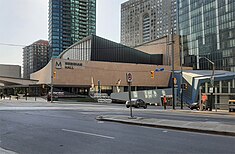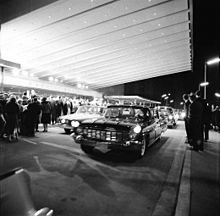Meridian Hall (Toronto)
This article has multiple issues.Please helpimprove itor discuss these issues on thetalk page.(Learn how and when to remove these template messages)
|
 Exterior view fromFrontandYonge Street | |
 | |
| Former names | O'Keefe Centre (1960–1996) Hummingbird Centre for the Performing Arts (1996–2007) Sony Centre for the Performing Arts (2007–2019) |
|---|---|
| Address | 1Front Street East Toronto,Ontario M5E 1B2 |
| Coordinates | 43°38′48″N79°22′34″W/ 43.6466°N 79.3761°W |
| Public transit | |
| Owner | City of Toronto government |
| Type | Performing arts venue |
| Capacity | 3,191 |
| Construction | |
| Opened | October 1, 1960 |
| Reopened | October 1, 2010 |
| Rebuilt | 2008–2010 |
| Years active | 1960–2008; 2010–present |
| Architect | Peter Dickinson |
| Website | |
| www | |
Meridian Hallis aperforming artsvenue inToronto,Ontario,and it is the country's largest soft-seat theatre.[1]The facility was constructed for theCity of Toronto municipal governmentand is currently managed byTO Live,anarms-lengthagency andregistered charitycreated by the city.[2][3]Located at 1Front Street East,the venue opened as theO'Keefe Centreon October 1, 1960. From 1996 to 2007, the building was known as theHummingbird Centre for the Performing Arts.[4][5]From 2007 to 2019, it was known as theSony Centre for the Performing Arts.On September 15, 2019, it was re-branded as Meridian Hall.
In 2008, theCity of Torontodesignated the theatre aheritage building.[6]That year, it also underwent renovations to restore features such as the marquee canopy andYork Wilson's lobby mural,The Seven Lively Arts.Restoration of the wood, brass and marble was undertaken, along with audience seating, flooring upgrades, new washrooms and reconfigured lobby spaces. Following two years of renovations and restoration work, the building reopened on October 1, 2010, fifty years to the date of the first opening night performance.
History
[edit]The Centre was built on land formerly occupied by a series of commercial buildings, including the Canadian Consolidated Rubber Company, and previously it was the site of theGreat Western Railway Terminal(later the Toronto Wholesale Fruit Market).[7]

The idea for a performing arts centre that could serve the needs of an increasingly dynamic city predates the building's opening by almost 20 years. In the mid-1940s,Nathan Phillipsissued a challenge to Toronto industrialists to underwrite the cost of a multipurpose centre for theatre, music and dance. Response to Phillips' challenge was not immediate.E.P. Taylor,the racehorse-loving head ofCanadian Breweries,which owned O'Keefe Brewing, offered in early 1955 to build a performing arts centre that would not only serve the needs of local institutions but increase the diversity of entertainment options available in Toronto. Toronto City Council immediately accepted the proposal in principle, but not until 1958 was the project finally approved to be built. Among others,United Churchspokesmen opposed the idea that money from the sale of beer would be used for community development.[8]Taylor assigned one of his key executives, Hugh Walker, to oversee building what was to be known, during its first 36 years, as the O'Keefe Centre.

The O'Keefe Centre opened on October 1, 1960, with ared-carpetgala.The first production wasAlexander H. Cohen's production of the pre-Broadwaypremiere ofLerner and Loewe'sCamelot,starringRichard Burton,Julie AndrewsandRobert Goulet.Camelot was followed bymusical productionsfeaturing such artists asEthel Merman,Mickey Rooney,Angela Lansbury,Alfred Drake,Yul Brynner,Carol Channing,Pearl Bailey,Katharine HepburnandRudolf Nureyev.[citation needed]
Popular music artists includingBob Dylan,Janet Jackson,Elton John,Steve Earle,Leonard Cohen,Elvis Costello(November 1978),David Bowie(June 1974),Lou Reed(June 2000), and bands such as TheGrateful Dead,[9]The Who,Jefferson Airplane(August 1967),Led Zeppelin(November 1969),Radiohead(June 2006),The Carpenters,The Clash(September 1979) andBeastie Boys(September 2007) played concerts at the performing arts venue.[10]
Other artists who have performed on the arts venue's stage in a range of solo shows, revues and jazz spectaculars include:Louis Armstrong,Duke Ellington,Marlene Dietrich,Diana Ross,Anne Murray,Tom Jones,Danny Kaye,Judy Garland,Sammy Davis Jr.,Bill Cosby,Jack Benny,Liza MinnelliandLiberace.[when?]The venue has also played host to several large-scale ballet and dance performances: theNational Ballet of Canadaheld seasonal performances at the venue from 1964 to 2006, and the venue has also seen frequent visits by theRoyal Winnipeg BalletandLes Grands Ballets Canadiens.The venue has also welcomed a wide range of international dance companies such asLes Ballets Africains,Britain's Royal Ballet,New York City Ballet,Dance Theatre of Harlem,theDutch National Ballet,theNational Ballet of Cuba,Alvin Ailey American Dance Theater,Ballet Folklorico of Mexico,as well as theKirovandBolshoi Balletcompanies from the then-Soviet Union.It was during a 1974 Bolshoi visit that a youngMikhail Baryshnikovdefectedfrom the Soviet Union by escaping the venue into a waiting getaway car, aided by laterJim PetersonPCand businessman Tim Stewart.[11]
Like The National Ballet,The Canadian Opera Companymade the Centre its home stage, from as early as 1961 to 2006. Many[who?]of Canada's greatest singers, as well as many international opera stars, have performed for Centre audiences in COC productions. In addition, although touring opera is now rare, in earlier days the performing arts venue played host toThe Metand to such well-known performers asBirgit Nilsson,Plácido DomingoandRenata Scotto.

In early February 1996, the facility was renamed the Hummingbird Centre in recognition of a major gift from a Canadian software company,Hummingbird Communications Ltd.[4]The $5-million donation allowed the Centre to undertake a number of capital improvements and repairs, including the installation of anelevatorand an acoustic reinforcement system for the auditorium.[12]In October 2006,OpenTextacquired Hummingbird and declined to renew its contract with the centre.[13]In September 2007, Sony bought the naming rights to the Centre for $10-million, and a ten-year partnership was born.[5]When the Ballet and Opera moved to theFour Seasons Centrein 2006, it left a hole in the theatre's schedule. At this point, programming shifted to amulticulturalschedule by include more content appealing to Toronto's manyethnicdiasporas.Notable performances that reflect this mandate includeThe Last Empress(a Korean historical musical), theVirsky Ukrainian Dance Company,South Africa'sSoweto Gospel Choir,The Shaolin Warriors,Ricky Cheng,David Rudder & Friendsand Club Tropicana.[citation needed]
In 2006, the performing arts venue received approval from the City of Toronto for the development of ahigh-risecondominiumbuilding beside the Centre. Designed by architectDaniel Libeskind(who also designed the Crystal addition to theRoyal Ontario Museum), theL Towerwas built on the southwest corner of the property. The Sony Centre closed on 26 June 2008 to begin the theatre renovations, which were unveiled on October 1, 2010.[14]
In June 2012, the Sony Centre hosted the Canadian premiere of thePhilip GlassandRobert WilsonoperaEinstein on the Beach.[15]
On 21 January 2019, the City of Toronto announced a C$30.75 million 15-year partnership withMeridian Credit Union,re-branding the Sony Centre into Meridian Hall, and theToronto Centre for the Artsinto the Meridian Arts Centre. The arts venues formally adopted their new names on September 15, 2019.[16][17][18]
Architecture
[edit]Designed byPeter Dickinson,the performing arts venue is an example of amid-twentieth century modernperforming arts venue. It is four stories high and is broken up into three main forms: the entrance block, auditorium and fly tower. The central form of the building is highly symmetrical with an open floor plan. Structurally, the performing arts venue uses steel trusses and concrete to hold the majority of the building together. In addition to the structure, the performing arts venue's auditorium houses an acoustic system, which gives the audience the sense that the sound is surrounding them.[19]
When it comes to materiality, the majority of the original materials are still in the building today. Materials used include: Alabamalimestone,glazing,granite,copper,bronze,Carrara marble,carpet,cherryplywoodpanelsandBrazilian rosewood.The performing arts venue is very diverse in its range of materials and employs them in such a way that they are not overshadowed by the unique forms of the building.[citation needed]
The interior also features a grand double-height foyer withcoffered ceilings,a 30 metres (98 ft) widemuralby the famous Toronto-born artistYork Wilson,cantilevered stairs,polished bronze auditorium doors, and a fan-shaped auditorium with a curvingbalcony.[citation needed]
See also
[edit]References
[edit]- ^"TOLive Portal".tolive.com.Retrieved2022-10-21.
- ^"TO Live".City of Toronto.25 August 2017.Retrieved25 November2021.
- ^"3 Venues. 1 Community. Countless Experiences".TO Live.Retrieved25 November2021.
- ^abRenzetti, Elizabeth (3 February 1996). "Say good-bye to the O'Keefe Centre".The Globe and Mail.Toronto. pp. A10.
- ^ab"Hummingbird Centre now Sony Centre".Toronto Star.7 September 2007.RetrievedSeptember 6,2013.
- ^"Watkiss, Ulli S., comp. O'Keefe Centre. Rep. Toronto, 2008. 1 Front Street East O'Keefe Centre. City of Toronto, 25 June 2008".Archived fromthe originalon 14 October 2012.Retrieved18 October2010.
- ^"Toronto's amazing intersection at Yonge and Front Streets".Historic Toronto.25 March 2013.RetrievedSeptember 15,2019.
- ^Rohmer, Richard (1978).E. P. Taylor: The Biography of Edward Plunket Taylor.McClelland and Stewart. p. 239.ISBN978-0-7710-7709-8.
- ^"Grateful Dead Live at O'Keefe Centre on 1967-08-04".4 August 1967.Retrieved15 September2019.
- ^"The history of the O'Keefe Centre in Toronto when it was the place to play".TO Blog.27 October 2012.Retrieved25 November2021.
- ^Knelman, Martin (5 October 2010)."Baryshnikov's defection is one for the books".Toronto Star.
- ^"Hummingbird to sing a new tune".The Globe and Mail.Toronto. 18 March 2009.RetrievedSeptember 6,2013.
The O'Keefe became the Hummingbird when the head of Toronto-based Hummingbird Ltd., Fred Sorkin, pledged $5-million to help cover the costs of some badly needed renovations to the centre.
- ^"Open Text Acquires Hummingbird"(Press release). OpenText. 2 October 2006.Retrieved25 November2021.
- ^Cullman, Roger (28 September 2010)."Sony Centre For The Performing Arts reopens".Blog TO.Retrieved25 November2021.
- ^"Philip Glass brings Einstein on the Beach to Toronto".CBC News.8 June 2012.Retrieved25 November2021.
- ^"Sony Centre for the Performing Arts to become Meridian Hall in September".To Do Canada.21 January 2019.Retrieved25 November2021.
The Sony Centre for the Performing Arts will be become Meridian Hall and Toronto Centre for the Arts in North York, Meridian Arts Centre from September 15, 2019.
- ^Lozowska, Marianna (January 21, 2019)."Sony Centre will be renamed Meridian Hall".NOW Magazine.RetrievedSeptember 15,2019.
On January 21, Mayor John Tory announced that arts organization Civic Theatres Toronto has struck a $30.75 million, 15-year partnership with Ontario's largest credit union that will result in Sony Centre for the Performing Arts rebranded as Meridian Hall and the Toronto Centre for the Arts renamed Meridian Arts Centre. The name changes will take effect on September 15.
- ^Mudhar, Raju (January 21, 2019)."Meridian Credit Union buys naming rights for Sony Centre and Toronto Centre for the Arts".Toronto Star.RetrievedSeptember 15,2019.
Beginning in September, the Sony Centre will be renamed Meridian Hall and the Toronto Centre for the Arts in North York will become the Meridian Arts Centre as part of a $30.75-million deal with the city.
- ^(Canadian Architect18)[full citation needed]
Bibliography
[edit]- Rohmer, Richard(1978).E. P. Taylor: the biography of Edward Plunket Taylor.McClelland & Stewart.ISBN0-7710-7709-2.
Further reading
[edit]- O'Keefe, John. "Sound Strategies." Canadian Architect 43.3 (March 1998): 18-19
- "The O'Keefe Centre for the Performing Arts, Toronto." Royal Architectural Institute of Canada 37 (Nov 1960): 461-488
